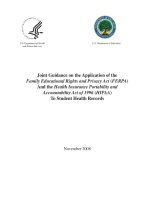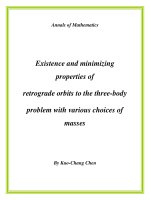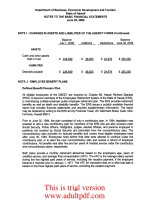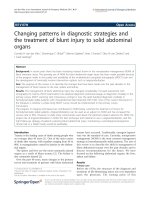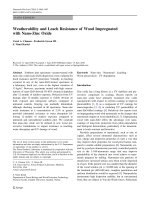Thermal combustion and oxygen chemisorption of wood exposed to low temperature long term heating 5
Bạn đang xem bản rút gọn của tài liệu. Xem và tải ngay bản đầy đủ của tài liệu tại đây (127.29 KB, 17 trang )
Chapter 5: Gas-solid Reaction
________________________________________________________________________
118
Chapter Five: Gas-solid Reaction
5 Introduction
In the study of spontaneous heating and ignition of wood, the role of gas-solid
reaction plays a critical role in making a material oxidizable and hence liable to self-
heating. It is generally agreed that carbon gasification involves, first, chemisorption on
the carbon to form carbon surface complexes, followed by desorption of these surface
complexes as carbon monoxide or dioxide (Teng and Hsieh 1999). Characterization of
either chemisorption or desorption process is important in the overall understanding of
the role of gas-solid reaction or oxidation in the materials (Degroot, Osterheld and
Richards 1991, Wang, Dlugogorski and Kennedy 1999, Wang, Dlugogorski and Kennedy
2003a).
This study is interested in the investigation of chemisorption as the initial step leading to
gasification, and it being a significant factor in controlling chemical reactivity and heat
release in the overall context of spontaneous heating and ignition. This study is concerned
with the interpretation of such oxygen chemisorption experiments for cellulosic chars,
through which the energetics of chemisorption process is elucidated in order to
characterize the reactivity of these cellulosic chars that have been created at low
temperatures. This chapter presents an analytical model to compute the energetics of
chemisorption, in order to characterize reactivity of wood chars. Experimental
Chapter 5: Gas-solid Reaction
________________________________________________________________________
119
preparation and procedures for chemisorption of cellulosic wood chars also warrant
special consideration as chemisorption on cellulosic chars differ from the graphitic
carbon such as coal in that these cellulosic chars are far more reactive. In addition to the
energetics of chemisorption, this study also investigates the changes in functional groups
arising from oxidation via Fourier-transform Infrared (FTIR) Spectroscopy. Experimental
procedures using FTIR for wood chars are discussed in this chapter.
5.1 Theoretical and experimental studies of chemisorption
In the description of the heterogeneous gas-solid reactions, including carbon-
oxygen reaction, the reaction rate is generally assumed to be proportional to the
accessible surface area (Khan, Everitt and Lui 1990, Teng and Hsieh 1999) . One of the
main interests in chemisorption study is to use oxygen chemisorption capacity to
characterise the active sites in carbon, by way of activation energy, in the attempt to
quantify reactivity of a given carbonized substrate (Teng et al. 1999). Correlation is made
possible on assumptions that the substance possesses a constant a number of reactive sites
per unit surface area, and the area have the same distribution activity (Carpenter and
Giddings 1964, Carpenter and Sergeant 1966, Bansal, Vastola and Walker 1970).
The fact that the activation energy for chemisorption is not constant but varies with
surface coverage have since proliferated a large number of studies in making different
attempts to quantify the possibility of a variety of sites so as to determine the overall
kinetics of the chemisorption process. For instance, Bansal, Vastola and Parker (1970)
Chapter 5: Gas-solid Reaction
________________________________________________________________________
120
have proposed that there were discrete types of active sites on carbon surface, relating to
the number of breaks observed in a single Elovich plot in a single chemisorption run.
They have suggested ways to identify the different regions of active sites in order to
calculate the activation energies.
More efforts have also been devoted to develop very complex kinetic models to compute
activation energy as a distribution, rather than discrete values. Waters Squires and
Laurendeau (1986) have developed a kinetic model using Collision theory and the
Freundlich isotherm to characterise activation energy by a continuous distribution for
turbostratic amorphous carbon. Floess, Lee and Oleksy (1991) also have developed a
distributed activation energy site model for microporous carbon. Suuberg (1983)
proposed the idea of Gaussian distributed activation energy models via approximate
solution for carbon char. Du, Sarofim and Longwell (1991) then continued to improve the
Gaussian form of activation energy distribution for oxygen adsorption on carbons, by the
use of an approximation technique suggested by Suuberg (1983), to determine the
activation energy distribution of surface complexes. Teng et al. (1999) also purported a
distributed kinetic parameter model similar to that of Floess et al. (1991), except that their
distribution function did not have a flat end, but resembled the tail end of a Gaussian
form. These distributed activation energy models generally hold a basic assumption that
the energy distribution for oxygen chemisorption is continuous, and in the main seek to
maintain generality in the allowable forms of the distribution function.
Chapter 5: Gas-solid Reaction
________________________________________________________________________
121
Unfortunately the use of complex kinetic models such as those described above may be
unattractive to those whose main concern is the modeling of combustion, rather than
pyrolytic processes. Even in these complex distributed models, the precise nature of the
pathways to final surface oxides is not considered in the analysis, rendering the treatment
pseudo-analytical (Wang, Dlugogorski and Kennedy 2003c). The creation and
destruction of the rate-controlling intermediate steps and active sites are also ignored in
these models in order to make them mathematically tractable. The complicated models,
albeit its complexity, thus examine only the irreversible oxygen adsorption. The use of
Gaussian distributed activation energy models inevitably results in more cumbersome
computational models; they certainly require more computational resources to handle
than simple first-order models.
The chemisorption kinetics has by far defied any plausible theory, without being pseudo-
analytical. The empirical methods are still after all the most probable way to correlate the
experimental data in order to calculate the instantaneous rates of adsorption which can be
used in a kinetic analysis. Several empirical methods have been put forth, such as
parabolic diffusion equation (Allardice 1966), power-law form rate equation (Khan et al.
1990) and exponential function (Wang, Dlugogorski and Kennedy 2002), in addition to
the Elovich equation. Both the parabolic diffusion equation and simple power-law model
have failed to account for the chemisorption kinetics, except the exponential function
proposed by Wang et al. (2002) is able to provide a very good fit to the experimental data
of bituminous coal, where the rate of oxygen consumption is described as the sum of one
constant and two exponential functions of time. Khan et al. (1990) other attempts at using
Chapter 5: Gas-solid Reaction
________________________________________________________________________
122
empirical models such as shrinking area model and diffusion model either was not able to
predict data over the entire range with one constant or encountered significant errors at
low surface coverage. They concluded that Elovich equation still offers the best
empirical method to describe the chemisorption kinetics.
The Elovich kinetic law is an empirical model that has found wide application in kinetic
studies of sorption process, particularly in the field of chemisorption (Laine, Vastola and
Walker 1960). This kinetic model is able to account for the variation of the energetics of
chemisorption with the extent of surface coverage (Allardice 1966).
Though first developed as an empirical model, the application of such empirical kinetic
law has been thoroughly examined on theoretical grounds. Taylor and Thon (1952) have
mathematically shown that adsorption process conforms to the Elovich equation.
Landsberg (1955) on the other hand developed very elaborate chemical models to justify
its form. Low (1960) presented a comprehensive discussion of the use of Elovich
equation in describing the chemisorption kinetics of gases on solids. Elovich equation has
continuously been applied to many experimental studies of chemisorption for carbonized
char (Carpenter and Giddings 1964, Carpenter and Sergeant 1966, Harris and Evans 1975,
Sevenster 1961, Suuberg, Wojtowicz and Calo 1989, Khan et al. 1990).
In this study, a distributed activation energy model has been developed based on Elovich
kinetic law to elucidate the energetics of chemisorption for low-temperature carbonized
Chapter 5: Gas-solid Reaction
________________________________________________________________________
123
wood char, in order to characterize the reactivity of these low-temperature, preheated
wood chars.
5.1.1 Analytical method to derive Elovich kinetics
Distributed Activation Energy Model
For a chemisorption process that conforms to Elovich kinetics, the rate of oxygen
uptake with respect to time can be described as
( )
( )
( )
0
11
ln lnq ab t t
bb
= ++
(5.1)
where
q
is the amount of oxygen adsorbed;
a
and
b
are Elovich constants and
0
t
is an
integration constants equal to
1 ab
. Substituting
0
1t ab=
into Equation (5.1) yields
( )
( )
( )
11
ln ln 1q ab abt
bb
= ++
(5.2)
If
abt
is >>1, a plot of
vs lnqt
should be a straight line, with a slope of
1
b
. At each
isothermal run, values of a and b can be calculated from Equation (5.2).
To derive the activation energy, the instantaneous rates are to be calculated for adsorption
at different amounts of surface coverage. The instantaneous rate is obtained by
Chapter 5: Gas-solid Reaction
________________________________________________________________________
124
substituting the Elovich constants
a
and
b
into the following differentiated form of
Elovich equation
exp( )
dq
a bq
dt
= −
(5.3)
Taking logarithm of both sides of Equation (5.3), and let
r dq dt=
yields
ln lnr a bq= −
(5.4)
Differentiating Equation (5.4) with respect to
1 T
gives
(ln ) ln ( )
(1 ) (1 ) (1 )
d r d a db
q
dT dT dT
= −
(5.5)
It has been suggested that
ln (1 ) /
c
d ad T E R= −
, where
c
E
is the apparent activation
energy and
R
is the universal gas constant (Bansal, Vastola and Walker 1970).
Rearranging Equation (5.5) yields
( )
ln
()
(1 ) (1 )
c
dr
E
db
q
R dT dT
=−+
(5.6)
Equation (5.6) suggests a distribution of activation energies for various surface coverages
with associated values of constants
a
and
b
.
Chapter 5: Gas-solid Reaction
________________________________________________________________________
125
5.1.2 Chemisorption experiments
Chemisorption experiments of wood chars warranted special attention as wood
chars were much reactive than coal chars, requiring different preparation and testing
procedures. Physical adsorption and chemisorption of oxygen on char samples were
measured thermogravimetrically in SDT 2960 simultaneous DTA-TGA
Thermogravimetric Analyzer © TA Instruments.
5.1.2.1 Materials and sample preparation
Kapor, a widely used hardwood species was used to create wood chars under low
temperature, in both long-term preheating in air and rapid pyrolysis in nitrogen in
thermogravimtric analyzer. The untreated Kapur is of empirical formula C
3.9
H
6.5
O
2.9
.
Two types of wood chars were used in the experiments: air-preheated wood chars, or
aerobically produced chars that have been heated in air for an extended period in oven,
and inert wood chars that were anaerobically created in nitrogen atmospheres.
5.1.2.2 Air-preheated chars
To prepare air-preheated chars, wood blocks measuring 32 x 32 x 102mm were heated
isothermally in air at heat treatment temperature (HTT) of 140°C for 50 days and HTT of
150°C for 30 days in Carbotlite oven. The powder air-preheated wood chars were then
Chapter 5: Gas-solid Reaction
________________________________________________________________________
126
obtained by grinding the wood discs sliced from the wood blocks and sieved to the
desired particle size of 200 to 300 μm. The wood powders were stored at 50%RH at 23°C
in a desiccator. These wood chars were designated as K140 and K150 respectively.
5.1.2.3 Inert-heated chars
Inert-heated samples were prepared by heating fresh wood powder at heat treatment
temperature (HTT) 300°C for 1.5 minutes in nitrogen at atmospheric pressure using
thermogravimetric analyser (TGA). The 1.5 minutes of pyrolysis time was selected to
approximate the condition of char formation by a smouldering combustion front
(Shafizadeh and Bradbury 1979)
.
These nascent wood chars were immediately subjected
to chemisorption after a few minutes of holding time in TGA to allow the respective
chemisorption temperatures to equilibrate. This process eliminated the formation of
surface oxides arising from separate char preparation and chemisorption runs. These
inert-heated wood chars were designated as K300.
5.1.2.4 Elemental analysis
The elemental composition of the respective wood chars are analysed and shown in
Tables 5.1 to 5.4.
Chapter 5: Gas-solid Reaction
________________________________________________________________________
127
Table 5.1. Elemental Analysis of Untreated Wood
Parameter
Weight Percent
Carbon
47.30
Hydrogen
6.56
Oxygen*
46.14
Empirical Formula
C
3.9
H
6.5
O
2.9
* composition obtained by difference
Table 5.2. Elemental Analysis of Inert Wood Chars (K300-1.5mins-N
2
)
Parameter
Weight Percent
Carbon
54.20
Hydrogen
5.70
Oxygen*
40.10
Empirical Formula
C
4.5
H
5.7
O
2.5
* composition obtained by difference
Table 5.3 Elemental Analysis of Preheated Wood Chars in Air for 30 days at 150°C)
(K150-30days-Air)
Parameter
Weight Percent
Carbon
47.37
Hydrogen
6.01
Oxygen*
46.62
Empirical Formula
C
3.9
H
6.0
O
2.9
* composition obtained by difference
Chapter 5: Gas-solid Reaction
________________________________________________________________________
128
Table 5.4 Elemental Analysis of Preheated Wood Chars in Air for 50 days at 140°C)
(K140-50days-Air)
Parameter
Weight Percent
Carbon
47.34
Hydrogen
5.88
Oxygen*
46.75
Empirical Formula
C
3.9
H
5.8
O
2.9
* composition obtained by difference
5.1.2.5 Argon purge
Argon was used to purge the balance enclosure at 750 sccm. Displacing the undesired
gases by introducing argon from the top produced a favourable density gradient in the
reactor during the purging process, since argon is the lighter gas and is therefore less
likely to mix with the displaced gas. Argon purging was carried out for approximately
five minutes to allow the sample weight reading to stabilise in a new buoyancy
environment.
5.1.2.6 Nitrogen purge
The initial argon purge rate was adjusted to 300 sccm. Nitrogen was introduced into the
reaction chamber through the reaction gas inlet at 250 sccm. A total reaction gas flow rate
was maintained at 250 sccm and 300 sccm respectively. The nitrogen gas used has less
Chapter 5: Gas-solid Reaction
________________________________________________________________________
129
than 20 ppm impurities and less than 10 ppm oxygenated species, i.e. O
2
, H
2
O, CO
2
and
CO. These low concentrations of oxygenated species were necessary to minimize char
oxidation during the nitrogen purge and the subsequent heat treatment. Nitrogen purge
was maintained for 60 minutes at 25°C. During this period, the reaction chamber would
be completely purged, the sample would lose some moisture and the gas-concentration
sensors would be completely flushed.
5.1.2.7 Empty pan correction
Because there would be small but measurable weight changes when a platinum empty
pan was subjected to chemisorption conditions, all weight data were corrected for weight
changes by running a blank experiment with an empty pan. The baseline weight data
would be used to subtract from each data point in the subsequent chemisorption
experiments.
5.1.2.8 Experimental Procedures
In a typical chemisorption experiment, the system was first purged with inert gases after
the loading of sample to remove any air introduced. The sample was pyrolysed to the
required heat treatment temperatures (HTT) in the case of inert chars; for air-preheated
chars, the chamber temperature was ramped directly from 25°C to the chemisorption
temperatures. In both cases, after the ramping and/or heat treatment segment, holding
time was allowed to stabilize the furnace temperature to the required chemisorption
Chapter 5: Gas-solid Reaction
________________________________________________________________________
130
temperatures (CST) before the reaction gas was valved in to start the chemisorption
experiment. The chemisorption temperatures (CST) used in the experiment were: 74°C,
109°C, 139°C, 168°C, 185°C and 207°C. The upper limit of the chemisorption
temperature was limited by the possibility of simultaneous desorption of oxides of carbon,
which normally occurs around 200°C (Allardice 1966).
For inert-heated samples, as soon as the chars were pyrolysed for 1.5 minutes at 300°C in
TGA, the furnace temperature was immediately cooled to the chemisorption temperatures
(CST). In each run, a few minutes of holding time were allowed for the chemisorption
temperature to equilibrate and to establish the weight of the sample prior to
chemisorption. Chemisorption was initiated by valving air with a flow rate of 60 ml/min
into the furnace that was maintained at isothermal chemisorption temperature. The weight
gain during chemisorption was monitored for 15 hours.
For air-preheated samples, the same procedure and condition were adopted, where the
air-preheated wood powders were heated from 25°C to the chemisorption temperature
and the weight gain was observed for 15 hours. However, there was no intercepting
heating segment to clean the surface oxides before chemisorption experiment. This was
because the removal of surface oxides would require the heating of these wood chars to
high temperatures. Unlike high-temperature carbonized chars (Bradbury and Shafizadeh
1980b, Hshieh and Richards 1991) that were created at heat treatment temperatures (HTT)
ranging from 375°C to 800°C, the low HTT of 140°C and 150°C for air-preheated chars
used in this study were less stable and these low temperature chars remained very
Chapter 5: Gas-solid Reaction
________________________________________________________________________
131
reactive towards heat. Preheating at high temperatures, even at 275°C for 30 minutes as
suggested by Hshieh and Richards (1989a)
would induce further pyrolysis and change
the composition of these air-preheated wood chars, which was certainly undesirable.
Furthermore, oxygen chemisorption onto these preheated wood chars would be negligible
(Bradbury and Shafizadeh 1980b). Therefore, intercepting heat segment to remove
surface oxides prior to chemisorption was not included in the programme.
5.2 Fourier-transform Infra Red (FTIR) Experiments
Fourier-transform Infrared Spectroscopy (FTIR) is a particularly useful technique
for characterization of char, allowing the observation of changes in individual functional
groups as a function of degree of oxidation (Shafizadeh and Sekiguchi 1984, Hshieh and
Richards 1991). FTIR offers several advantages over dispersive instrument, essentially
through the use of an interferometer, rather than a system of gratings and slits, that result
in a higher energy throughput to the detector. The FTIR spectrometer acquires and
digitizes the interferogram, performs the fourier transform function, and outputs the
spectrum, in either transmittance spectrum or absorbance spectrum.
In this study, the FTIR analysis of wood chars and oxygen-chemisorbed wood chars were
performed on IRPrestige-21 Spectroscopy. IRPrestige-21 has a single beam optics system
which can measure the wavelength in the range of 7800-350 cm
-1
, and is equipped with a
high signal to noise ratio (40,000:1). The high signal/noise and resolution of Fourier
transform spectroscopy was utilized to observe low concentrations of surface functional
Chapter 5: Gas-solid Reaction
________________________________________________________________________
132
groups COOH and C=O on a high absorptivity background (O'Reilly and Mosher 1983).
Computer assisted analysis of the spectra allowed qualitative and quantitative information
to be derived from the experimental data. The purpose of this FTIR study is to identify
the types of groups present and to assess the relative amounts of the different species.
5.2.1 Sample preparation
The char samples, including air-preheated chars, inert chars and oxygen-
chemisorbed chars were reduced into powder by grinding and sieving. Char powder
specimens were oven-dried at 150
o
C for 24 hours prior to FTIR experiments to minimize
moisture bands which interfere in the spectra, particularly in the OH absorption region at
3400-3600 cm
-1
(Starsinic et al. 1983).
5.2.2 Experimental procedures
The FTIR analysis of wood char was performed on IRPrestige-21 with 1024 scans
collected at a resolution of 4 cm
-1
; the noise level in the mid-range 2200-2800 cm
-1
was
+0.001 absorbance. Lower noise or higher resolution lead to prohibitively longer times
(2-4hr) because signal/noise is proportional to the (number of scans) and scan time varies
inversely with resolution (O'Reilly and Mosher 1983, Starsinic et al. 1983).
Background spectra were recorded using a blank KBr disk which was measured with 512
scans and used as a reference. Absorbances were calculated from the ratio of the intensity
of the sample to the reference without corrections for reflected light. In the background
Chapter 5: Gas-solid Reaction
________________________________________________________________________
133
spectra, characteristic bands measured around 3500 cm
-1
and 1630 cm
-1
are ascribed to
atmospheric water vapors and the bands at 2350 cm
-1
and 667 cm
-1
are attributed to
carbon dioxide (Hshieh and Richards 1991).
The actual spectra were measured with potassium bromide (KBr) discs containing char
powder mixed with potassium bromide (KBr) in a ratio of 1:100 (see Figures 5.5 and 5.6.)
Discs 12.7 mm diameter and 1 mm thick (see Figures 5.7 and 5.8) were pressed in a
vacuum KBr press (Perkin-Elmer) at 100,000 psi.
Figure 5.5 Wood samples in powder form
Figure 5.6 Samples mixed with KBr
Figure 5.7 The thin pellet pressed from the
mixture
Figure 5.8 The thin pellet in the sample
holder
Chapter 5: Gas-solid Reaction
________________________________________________________________________
134
5.2.3 Concluding remarks for chemical investigation on self-heating
This chapter presented a system of methods to assess propensity of wood chars for self-
heating from chemical viewpoint. An analytical model was developed to determine the
activation energy for chemisorption of cellulosic wood chars, following chemisorption
experiments of wood chars prepared under specific conditions. Elemental analysis was
carried out to identify preliminary effects of heat treatment temperatures on the changes
in chemical functional groups. The experimental method of Fourier-transform Infra-red
Spectroscopy was conducted to study chemical changes in wood chars. The analytical
framework for propensity of wood chars from chemical viewpoint was illustrated
diagrammatically below.
Figure 5.9: Methodology framework for analysis of propensity of self-ignition in
wood chars
PREHEATED
WOOD CHARS
ELEMENTAL
ANALYSIS
CHEMISORPTION
FTIR
EXPERIMENTS
PROPENSITY FOR
SELF-IGNITION
PROXIMATE ANALYSIS
Carbon
Hydrogen
Oxygen
OXYGEN ADSORPTION
• INERT WOOD CHARS
• AIR-PREHEATED
WOOD CHARS
N
2
-300°C
Air -140°C-30days
Air -150°C-50days
CHARACTERISATION OF
FUNCTIONAL GROUPS
-CH
2
group
C=O group
aliphatic vs.
aromatic groups
